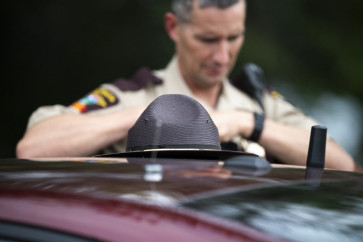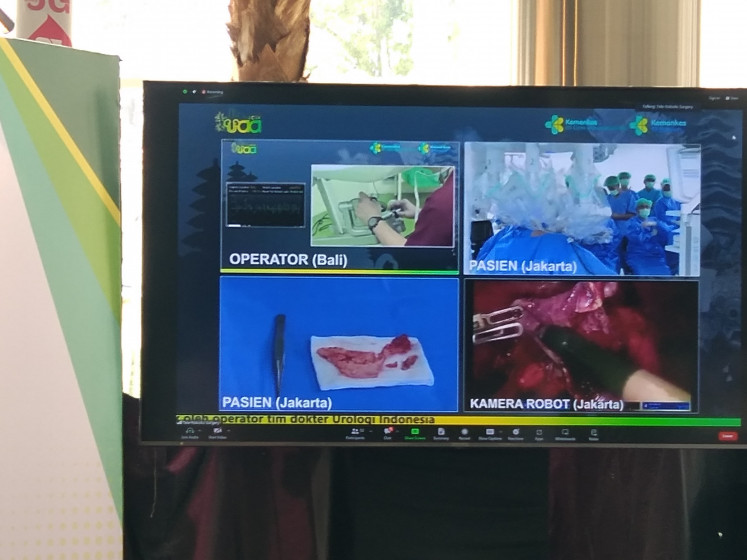Popular Reads
Top Results
Can't find what you're looking for?
View all search resultsPopular Reads
Top Results
Can't find what you're looking for?
View all search resultsTotal eclipse of the sun to darken slice of Indonesia
Indonesian children look up through x-ray film sheets to watch an annular solar eclipse in the sky in Anyer Beach, Banten province, Jan
Change text size
Gift Premium Articles
to Anyone
 Indonesian children look up through x-ray film sheets to watch an annular solar eclipse in the sky in Anyer Beach, Banten province, Jan. 26, 2009. (AP/Achmad Ibrahim) (AP/Achmad Ibrahim)
Indonesian children look up through x-ray film sheets to watch an annular solar eclipse in the sky in Anyer Beach, Banten province, Jan. 26, 2009. (AP/Achmad Ibrahim) (AP/Achmad Ibrahim)
I
span class="caption">Indonesian children look up through x-ray film sheets to watch an annular solar eclipse in the sky in Anyer Beach, Banten province, Jan. 26, 2009. (AP/Achmad Ibrahim)
The rare and awe-inspiring spectacle of a total solar eclipse will unfold over parts of Indonesia and the Indian and Pacific Oceans on Wednesday, weather permitting. The full eclipse may be visible to several million people within its narrow path including eclipse chasers who have traveled from around the world for a chance to witness it.
WHAT CAUSES A TOTAL SOLAR ECLIPSE?
At least twice a year, the orbits of the moon and earth result in the moon casting a shadow on the earth that blocks the sun. Most eclipses are partial but when the moon is close enough to the earth, the sun is completely eclipsed and only a faint ring of rays known as the corona is visible. The last total solar eclipse was in March 2015. The best reported viewing was on Norway's Svalbard islands near the North Pole. The previous total eclipse was in November 2012.
WHERE WILL THE ECLIPSE BE VISIBLE?
The total eclipse is visible within a roughly 100-150 kilometer-wide path that begins in the Indian Ocean and slices across parts of Indonesia including Sumatra, Kalimantan and Sulawesi before ending in the northern Pacific Ocean. Jakarta is not within the eclipse path, but the Sumatran port city of Palembang with a population of more than 1.4 million is. Cloudy skies, however, can make the much anticipated event a disappointment. And there's a high chance of cloud because Indonesia is in its wet season. People in South Asia, East Asia and the north and east of Australia may see a partial eclipse.
HOW LONG WILL THE ECLIPSE LAST?
The entire eclipse, which begins with the first patch of darkness appearing on the edge of the sun, will last about three hours. For the viewer, the exact duration of the total phase of the eclipse depends on their location along the path. The moments in which the sun is entirely obscured will last between 90 seconds and 4 minutes. Palembang in Sumatra will be the first major city to see the total eclipse, at about 7:20 a.m. local time. The point at which the total eclipse lasts the longest, 4 minutes and 9 seconds, is in the Pacific Ocean east of the Philippines. On land the durations are mostly between 1 and 3 minutes.
IS THE ECLIPSE SAFE TO LOOK AT?
It is dangerous to look at the sun with the naked eye during a partial eclipse, the partial phases of a total eclipse and another type of eclipse called the annular eclipse, particularly using devices such as telescopes. NASA recommends special filters that are coated with a fine layer of aluminum, chromium or silver such as the darkest welder's glass. Filters made of aluminized polyester in the darkest shades are also safe. The filters should be specifically designed for the binoculars and telescopes that they will be fitted to. Another safe but cumbersome and probably unsatisfying method of viewing is pinhole projection of the image onto a screen. During the spectacular moments of total eclipse it is safe to look at the sun with the naked eye.
HOW IS INDONESIA PREPARING?
Authorities have been promoting the eclipse as a tourism event locally and internationally since 2014. Because of their rarity, total eclipses are a magnet for scientists and astronomy enthusiasts known as eclipse chasers. Overseas tour agencies have chartered ships for groups who want to view the eclipse at sea and many land tours, which are the best for photography, have also been organized. Oklahoma-based Spears Travel says a group led by a former NASA scientist it has booked on a special Holland America Line cruise is made up of people from Canada, the US, Britain, China and Iran. An eclipse festival is planned for Palu, Central Sulawesi, and 11 cities in total are being promoted as places where the total eclipse could be clearly viewed.









